The Claas Jaguar 970 is the second but one from the top of the Claas harvester range and produces an impressive 775hp.

Quigley Agri Contracting cutting whole crop triticale in Co Wicklow.
This one is owned and operated by Quigley Agri Contractors and is currently munching its way through acres of wholecrop in an effort to help dairy farmers fill a void in next winter’s fodder supplies, which are being eroded by the current drought.
The machine is fitted with a Claas direct disc 520 header. This was purchased with Quigley’s previous harvester in 2016, a smaller Jaguar 870. Internally, it has been fitted with an upgraded cracker unit with 150 teeth instead of 100 for a standard maize cracker. This is so the grains are crushed properly during the chopping process. So far this year, the harvester has clocked up 400 hours between grass silage and the wholecrop that they are currently working on.
It will take around a month to get through the wholecrop this season from start to finish.
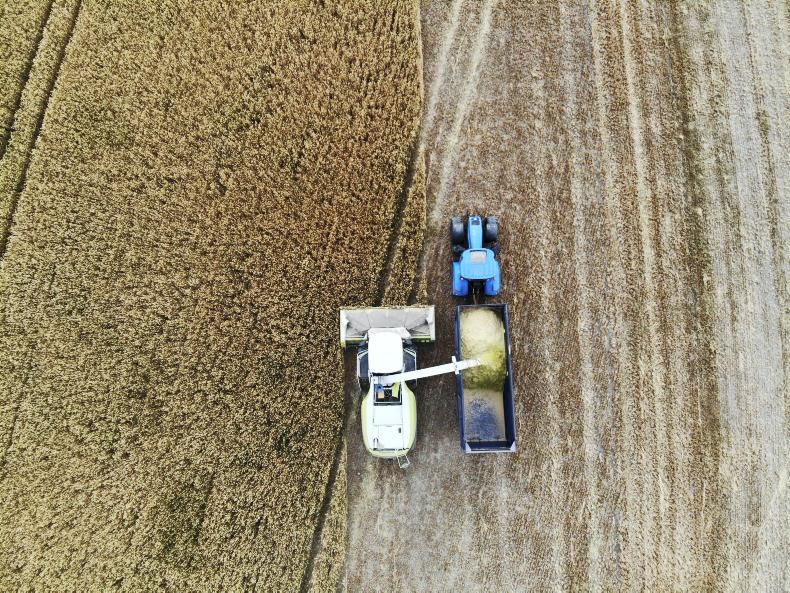
Quigley Agri Contracting cutting whole crop triticale in Co Wicklow.
Normally, they would bring the grass pickup with them and pick some grass to put on top of the pit to make it less tempting for birds to pick the plastic, but, currently, the grass header has been staying at home, as there is no grass to pick up.
The output of this outfit is impressive, with 60 acres being very possible if there isn’t a lot of moving and 40 acres achievable on a normal day.
Hydraulic clamping
This machine is the latest model from Claas and one of the new features is the hydraulic clamping of the shear bar.
During shear bar adjustment, the hydraulic clamp is released, allowing the shear bar to be adjusted without resistance, which allows the shear bar to be set more accurately and puts less stress on the bar’s components. Once the shear bar has been set, the hydraulic system clamps and holds the shear bar in position.
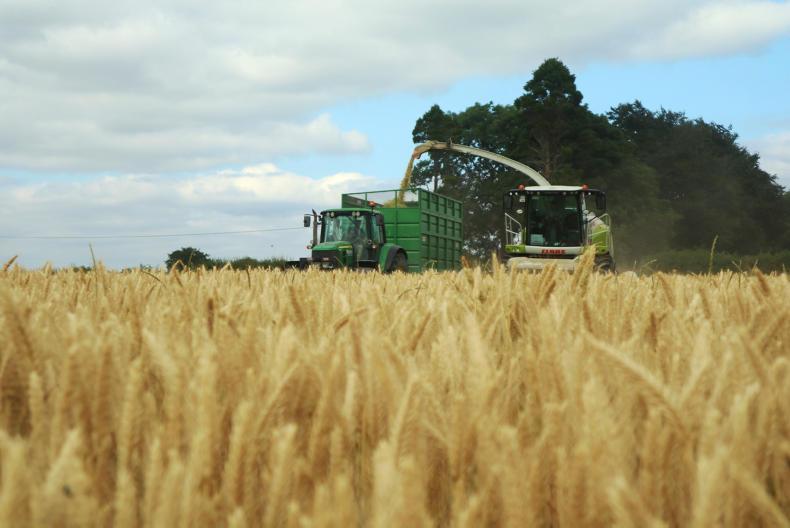
Quigley Agri Contracting cutting whole crop triticale in Co Wicklow.
This new model also comes with an automatically adjusted chopping cylinder concave, which is attached directly to the shear bar mounting system and is automatically moved with the shear bar when it is adjusted.
This means that the distance between the concave and the chopper cylinder remains constant as the chopping cylinder blades wear, thereby ensuring an even crop flow, regardless of the condition of the blades.
In the cab
Sitting up in the harvester with Michael Quigley, you can see how this sort of output is possible. Even with this sort of horsepower, you could hear the machine labouring when the chop length was shortened and the cracker engaged in what was a very even and heavy crop of triticale.
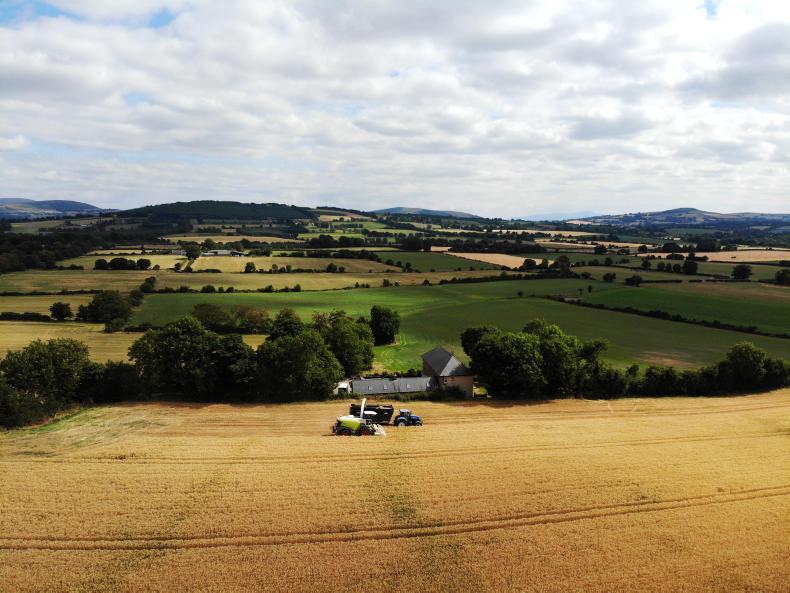
Quigley Agri Contracting cutting whole crop triticale in Co Wicklow.
Speaking to Michael, he said that he reckons he will cut twice his normal acreage of wholecrop this year and has both end-users and growers looking to do deals for the last of the winter crops and the start of the spring crops.
With a harvester this size, you need serious trailers to keep the chopped material away. Quigleys run a pair of Smyth Super-cubes on the back of New Holland T7200s as the main haulage, with a John Deere 6830 on a 20ft normal Smyth also on duty.
These Super-cubes were the first two to come out of the Smyth factory and the Quigleys were involved in the design process. These trailers came to the Quigleys in 2016, so this is their third season and they find the extra cubic metres that they give over a normal trailer essential to keep the big Claas moving.
When filing the trailer, the Claas comes with a spout camera, which allows the operator to see down into the trailer from the comfort of the driver’s seat.
There is also a camera on the hitch, which allows a trailer to be hitched from the driver’s seat without anyone having to be in the danger area between the harvester and the trailer.
This year is not an issue with the dry weather, but the pulling of a trailer can be very difficult in some years. This machine has been specified with four-wheel-drive, which makes it very stable in wet conditions and when pulling a trailer, either opening up headlands or splitting a field in maize.
In wholecrop, the spout is swivelled from side to side and the crop is cut from one straight edge.
With another week or so to go of the winter wholecrop and then a smaller amount of spring to get through, Quigleys are putting their new harvester to good use in its first year with them.
The Claas Jaguar 970 is the second but one from the top of the Claas harvester range and produces an impressive 775hp.

Quigley Agri Contracting cutting whole crop triticale in Co Wicklow.
This one is owned and operated by Quigley Agri Contractors and is currently munching its way through acres of wholecrop in an effort to help dairy farmers fill a void in next winter’s fodder supplies, which are being eroded by the current drought.
The machine is fitted with a Claas direct disc 520 header. This was purchased with Quigley’s previous harvester in 2016, a smaller Jaguar 870. Internally, it has been fitted with an upgraded cracker unit with 150 teeth instead of 100 for a standard maize cracker. This is so the grains are crushed properly during the chopping process. So far this year, the harvester has clocked up 400 hours between grass silage and the wholecrop that they are currently working on.
It will take around a month to get through the wholecrop this season from start to finish.

Quigley Agri Contracting cutting whole crop triticale in Co Wicklow.
Normally, they would bring the grass pickup with them and pick some grass to put on top of the pit to make it less tempting for birds to pick the plastic, but, currently, the grass header has been staying at home, as there is no grass to pick up.
The output of this outfit is impressive, with 60 acres being very possible if there isn’t a lot of moving and 40 acres achievable on a normal day.
Hydraulic clamping
This machine is the latest model from Claas and one of the new features is the hydraulic clamping of the shear bar.
During shear bar adjustment, the hydraulic clamp is released, allowing the shear bar to be adjusted without resistance, which allows the shear bar to be set more accurately and puts less stress on the bar’s components. Once the shear bar has been set, the hydraulic system clamps and holds the shear bar in position.

Quigley Agri Contracting cutting whole crop triticale in Co Wicklow.
This new model also comes with an automatically adjusted chopping cylinder concave, which is attached directly to the shear bar mounting system and is automatically moved with the shear bar when it is adjusted.
This means that the distance between the concave and the chopper cylinder remains constant as the chopping cylinder blades wear, thereby ensuring an even crop flow, regardless of the condition of the blades.
In the cab
Sitting up in the harvester with Michael Quigley, you can see how this sort of output is possible. Even with this sort of horsepower, you could hear the machine labouring when the chop length was shortened and the cracker engaged in what was a very even and heavy crop of triticale.

Quigley Agri Contracting cutting whole crop triticale in Co Wicklow.
Speaking to Michael, he said that he reckons he will cut twice his normal acreage of wholecrop this year and has both end-users and growers looking to do deals for the last of the winter crops and the start of the spring crops.
With a harvester this size, you need serious trailers to keep the chopped material away. Quigleys run a pair of Smyth Super-cubes on the back of New Holland T7200s as the main haulage, with a John Deere 6830 on a 20ft normal Smyth also on duty.
These Super-cubes were the first two to come out of the Smyth factory and the Quigleys were involved in the design process. These trailers came to the Quigleys in 2016, so this is their third season and they find the extra cubic metres that they give over a normal trailer essential to keep the big Claas moving.
When filing the trailer, the Claas comes with a spout camera, which allows the operator to see down into the trailer from the comfort of the driver’s seat.
There is also a camera on the hitch, which allows a trailer to be hitched from the driver’s seat without anyone having to be in the danger area between the harvester and the trailer.
This year is not an issue with the dry weather, but the pulling of a trailer can be very difficult in some years. This machine has been specified with four-wheel-drive, which makes it very stable in wet conditions and when pulling a trailer, either opening up headlands or splitting a field in maize.
In wholecrop, the spout is swivelled from side to side and the crop is cut from one straight edge.
With another week or so to go of the winter wholecrop and then a smaller amount of spring to get through, Quigleys are putting their new harvester to good use in its first year with them.










 This is a subscriber-only article
This is a subscriber-only article












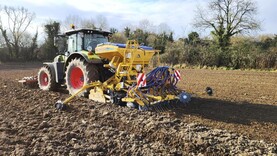
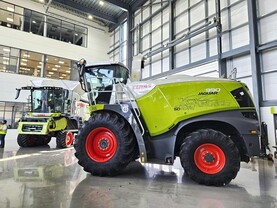


SHARING OPTIONS: